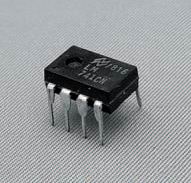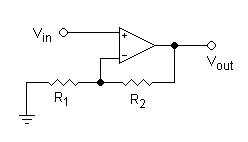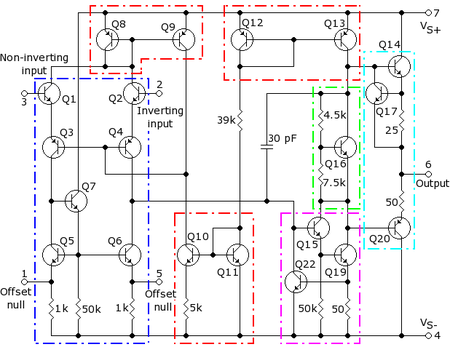Operational amplifier
A 741 operational amplifier in an 8 pin dual in line package |
An operational amplifier, usually referred to as an 'op-amp' for brevity, is a DC-coupled high-gain electronic voltage amplifier with differential inputs and, usually, a single output. In its ordinary usage, the output of the op-amp is controlled by negative feedback which, because of the amplifier's high gain, almost completely determines the output voltage for any given input. Op-amps are among the most widely used electronic devices today, being utilized in a vast array of consumer, industrial and scientific devices. General-purpose integrated op-amps of standard specification sell for well under one U.S. dollar. Modern designs are electronically more rugged than earlier implementations and some can sustain direct short-circuits on their outputs without damage. |
History
The operational amplifier was originally designed to perform mathematical operations - hence its name - by using voltage as an analogue of another quantity. This is the basis of the analogue computer where op-amps were used to model the basic mathematical operations (addition, subtraction, integration, differentiation, and so on). However, an ideal operational amplifier is an extremely versatile circuit element, with a great many applications beyond mathematical operations. Practical op-amps, based on transistors, tubes, or other amplifying components and implemented as discrete or integrated circuits, are approximations to the ideal.
Op-amps were originally developed in the vacuum tube era, where they were used in analog computers. Op-amps are now normally implemented as integrated circuits (ICs), though versions with discrete components are used when performance beyond that attainable with ICs is required.
The first integrated op-amp to become widely available, in the late 1960s, was the bipolar Fairchild μA709, created by Bob Widlar in 1965; it was rapidly superseded by the 741, which has better performance and is more stable and easier to use. The μA741 is still in production, and has become ubiquitous in electronics - many manufacturers produce a version of this classic chip, recognisable by containing "741" in the part number. Better designs have since been introduced, some based on the FET (late 1970s) and MOSFET (early 1980s). Many of these more modern devices can be substituted into an older 741-based circuit and work with no other changes, to give better performance.
Op-amps usually have parameters within tightly specified limits, with standardized packaging and power supply needs. Op-amps have many uses in electronics - the operational amplifier is probably the most useful single device in analog electronic circuitry. With only a handful of external components, it can be made to perform a wide variety of analog signal processing tasks. Many standard IC op-amps cost only a few cents in moderate production volume, but integrated or discrete amplifiers with non-standard specifications may cost over $100 US in small quantities.
Basic operation
The amplifier's differential inputs consist of an inverting input and a non-inverting input and ideally the op-amp amplifies only the difference in voltage between the two. This is called the "differential input voltage." In its most common use, the op-amp's output voltage is controlled by feeding a fraction of the output signal back to the inverting input. This is known as negative feedback. If that fraction is zero, i.e., there is no negative feedback, the amplifier is said to be running "open-loop" and its output is the differential input voltage multiplied by the total gain of the amplifier, as shown by the following equation:
Because of this high open-loop gain, op-amps are not usually used without negative feedback. Unless the differential input voltage is extremely small, saturation (see below in Nonlinear imperfections) results in open-loop operation. An example of how the output voltage is calculated when negative feedback exists is shown below in Basic non-inverting amplifier circuit, below.
The ideal op-amp
For any input voltages the ideal op-amp has infinite open-loop gain, infinite bandwidth, infinite input impedances resulting in zero input currents, infinite slew rate, zero output impedance and zero noise.
Real op-amps can only approximate to this ideal, and the actual parameters are subject to drift over time and with changes in temperature, input conditions, etc. Modern integrated FET or MOSFET op-amps approximate more closely to these ideals than bipolar ICs where large signals must be handled at room temperature over a limited bandwidth; input impedance, in particular, is much higher, although the bipolar op-amps usually exhibit superior (i.e., lower) input offset drift and noise characteristics.
Where the limitations of real devices can be ignored, an op-amp can be viewed as a Black Box with gain; circuit function and parameters are determined by feedback, usually negative. IC op-amps as implemented in practice are moderately complex integrated circuits; see the internal circuitry for the relatively simple 741 op-amp below, for example.
Equations and sample op-amp circuits are here: Operational amplifier applications
Limitations of real op-amps
DC imperfections:
- Finite gain - the effect is most pronounced when the overall design attempts to achieve gain close to the inherent gain of the op-amp.
- Finite input resistance - this puts an upper bound on the resistances in the feedback circuit. Some op-amps have circuitry to protect inputs from excessive voltage: this makes input parameters slightly worse. Some op-amps are available in protected (thus slightly degraded) and unprotected versions.
- Nonzero output resistance - important for low resistance loads. Except for very small voltage output, power considerations usually come into play first.
- Input bias current - a small amount of current (typically ~10 nA for bipolar op-amps, or picoamperes for CMOS designs) flows into the inputs. This current is mismatched slightly between the inverting and non-inverting inputs (there is an input offset current). This effect is usually important only for very low power circuits.
- Input offset voltage - the op amp will produce an output even when the input pins are at exactly the same voltage. For circuits which require precise DC operation, this effect must be compensated for; many practical op-amps have an offset compensation input.
- Common mode gain - A perfect operational amplifier amplifies only the voltage difference between its two inputs, completely rejecting all voltages that are common to both. However, the differential input stage of an operational amplifier is never perfect, leading to the amplification of these identical voltages to some degree. The standard measure of this defect is called the common-mode rejection ratio (denoted, CMRR). Minimization of common mode gain is usually important in non-inverting amplifiers (described below) that operate at high amplification.
AC imperfections:
- Finite bandwidth - all amplifiers have a finite bandwidth. However, this is more pronounced in op amps, which use internal frequency compensation to increase the phase margin.
- Input capacitance - most important for high frequency operation.
- Common mode gain - See DC imperfections, above.
Nonlinear imperfections:
- Saturation - output voltage is limited to a peak value, usually slightly less than the power supply voltage. Saturation occurs when the differential input voltage is too high for the op-amp's gain, driving the output level to that peak value.
- Slewing - the amplifier's output voltage reaches its maximum rate of change. Measured as the slew rate, it is usually specified in volts per microsecond. When slewing occurs, further increases in the input signal have no effect on the output. Slewing is usually caused by internal capacitances in the amplifier, especially those used to implement its frequency compensation.
- Non-linear transfer function - The output voltage may not be accurately proportional to the difference between the input voltages. It is commonly called distortion when the input signal is a waveform. This effect will be very small in a practical circuit if substantial negative feedback is used.
Power considerations:
- Limited output power - if high power output is desired, an op-amp specifically designed for that purpose must be used. Most op-amps are designed for low power operation and are typically only able to drive output resistances down to 2 kΩ.
- Limited output current - the output current must obviously be finite. In practice, most op-amps are designed to limit the output current so as not to exceed a specified level - around 25 mA for a type 741 IC op-amp - thus protecting the op-amp and associated circuitry from damage.
Notation
The usual circuit symbol for an op-amp is:
where:
- V+: non-inverting input
- V-: inverting input
- Vout: output
- VS+: positive power supply (sometimes also VDD, VCC, or VCC + )
- VS-: negative power supply (sometimes also VSS, VEE, or VCC - )
The power supply pins (VS+ and VS-) can be labeled in different ways. Despite different labeling, the function remains the same. Often these pins are left out of the diagram for clarity, and the power configuration is described or assumed from the circuit. The positions of the inverting and non-inverting inputs may be reversed in diagrams where appropriate; the power supply pins are not commonly reversed (but are sometimes).
Use in electronics system design
The use of op-amps as circuit blocks is much easier and clearer than specifying all their individual circuit elements (transistors, resistors, etc.), whether the amplifiers used are integrated or discrete. In the first approximation op-amps can be used as if they were ideal differential gain blocks; at a later stage limits can be placed on the acceptable range of parameters for each op-amp.
Circuit design follows the same lines for all electronic circuits. A specification is drawn up governing what the circuit is required to do, with allowable limits. For example, the gain may be required to be 100 times, with a tolerance of 5% but drift of less than 1% in a specified temperature range; the input impedance not less than 1 megohm; etc.
A basic circuit is designed, often with the help of circuit modelling (on a computer). Specific commercially available op-amps and other components are then chosen that meet the design criteria within the specified tolerances at acceptable cost. If not all criteria can be met, the specification may need to be modified.
A prototype is then built and tested; changes to meet or improve the specification, alter functionality, or reduce the cost, may be made.
DC behaviour
Open-loop gain is defined as the amplification from input to output without any feedback applied. For most practical calculations, the open-loop gain is assumed to be infinite; in reality it is obviously not. Typical devices exhibit open-loop DC gain ranging from 100,000 to over 1 million; this is sufficiently large for circuit gain to be determined almost entirely by the amount of negative feedback used. Op-amps have performance limits that the designer must keep in mind and sometimes work around. In particular, instability is possible in a DC amplifier if AC aspects are neglected.
AC behaviour
The op-amp gain calculated at DC does not apply at higher frequencies. To a first approximation, the gain of a typical op-amp is inversely proportional to frequency. This means that an op-amp is characterized by its gain-bandwidth product. For example, an op-amp with a gain bandwidth product of 1 MHz would have a gain of 5 at 200 kHz, and a gain of 1 at 1 MHz. This low-pass characteristic is introduced deliberately, because it tends to stabilize the circuit by introducing a dominant pole. This is known as frequency compensation.
Typical low cost, general purpose op-amps exhibit a gain bandwidth product of a few megahertz. Specialty and high speed op-amps can achieve gain bandwidth products of hundreds of megahertz. For very high-frequency circuits, a completely different form of op-amp called the current-feedback operational amplifier is often used.
Basic non-inverting amplifier circuit
The general op-amp has two inputs and one output. The output voltage is a multiple of the difference between the two inputs (some are made with floating, differential outputs):
- Vout = G(V+ − V−)
G is the open-loop gain of the op-amp. The inputs are assumed to have very high impedance; negligible current will flow into or out of the inputs. Op-amp outputs have very low source impedance.
If the output is connected to the inverting input, after being scaled by a voltage divider K = R1 / (R1 + R2), then:
- V+ = Vin
- V− = K Vout
- Vout = G(Vin − K Vout)
Solving for Vout / Vin, we see that the result is a linear amplifier with gain:
- Vout/Vin = G/(1 + G K)
If G is very large, Vout/Vin comes close to 1/K, which equals 1 + (R2/R1).
This negative feedback connection is the most typical use of an op-amp, but many different configurations are possible, making it one of the most versatile of all electronic building blocks.
When connected in a negative feedback configuration, the op-amp will try to make Vout whatever voltage is necessary to make the input voltages equal. This, and the high input impedance, are sometimes called the two "golden rules" of op-amp design (for circuits that use feedback):
- No current will flow into the inputs.
- The input voltages will be equal to each other.
The exception is if the voltage required is greater than the op-amp's supply, in which case the output signal stops near the power supply rails, VS+ or VS−.
Most single, dual and quad op-amps available have a standardized pin-out which permits one type to be substituted for another without wiring changes. A specific op-amp may be chosen for its open loop gain, bandwidth, noise performance, input impedance, power consumption, or a compromise between any of these factors.
Internal circuitry of 741 type op-amp
Although it is useful and easy to treat the op-amp as a black box with a perfect input/output characteristic, it is important to understand the inner workings, so that one can deal with problems that may arise due to internal design limitations.
Though designs vary between products and manufacturers, all op-amps have basically the same internal structure, which consists of three stages:
- Differential amplifier
- Input stage - provides low noise amplification, high input impedance, usually a differential output
- Voltage amplifier
- Provides high voltage gain, a single-pole frequency roll-off, usually single-ended output
- Output amplifier
- Output stage - provides high current driving capability, low output impedance, current limiting and short circuit protection circuitry
A component level diagram of the common 741 op-amp
Current mirrors
The sections outlined in red are current mirrors. The primary current, from which other standing (bias) currents are generated, is determined by the chip's power supply and the 39 kΩ resistor acting (with the two transistor diode junctions) as a current source. The current generated is approximately (VS+ − VS− − 2Vbe)/39 kΩ. The input stage DC conditions are controlled by the two current mirrors on the left. The current mirror formed by Q8/Q9 allows for large common mode voltages on the inputs without exceeding the active range of any transistor in the circuit. The current mirror Q10/Q11 is used, indirectly, to set the input stage current. This current is set by the 5 kΩ resistor. The input stage bias control acts in the following manner. The outputs of current mirrors, Q8/Q9 and Q10/Q11 together form a high impedance current differencing circuit. If the input stage current tends to deviate (as detected by Q8) from that set by Q10, this is mirrored in Q9 and any change in this current is corrected by altering the voltage at the bases of Q3 and Q4. Thus the input stage DC conditions are stabilised by a high gain negative feedback system.
The top-right current mirror Q12/Q13 provides a constant current load for the class A gain stage, via the collector of Q13, that is largely independent of the output voltage.
Differential input stage
The blue outlined section is a differential amplifier. Q1 and Q2 are input emitter followers and together with the common base pair Q3 and Q4 form the differential input stage. In addition, Q3 and Q4 also act as level shifters and provide voltage gain to drive the class A amplifier. They also help to increase the reverse Vbe rating on the input transistors.
The differential amplifier formed by Q1 - Q4 drives a current mirror active load formed by transistors Q5 - Q7. Q7 increases the accuracy of the current mirror by decreasing the amount of signal current required from Q3 to drive the bases of Q5 and Q6. This current mirror provides differential to single ended conversion as follows:
The signal current of Q3 is the input to the current mirror while the output of the mirror (the collector of Q6) is connected to the collector of Q4. Here, the signal currents of Q3 and Q4 are summed. For differential input signals, the signal currents of Q3 and Q4 are equal and opposite. Thus, the sum is twice the individual signal currents. This completes the differential to single ended conversion.
The open circuit signal voltage appearing at this point is given by the product of the summed signal currents and the paralleled collector resistances of Q4 and Q6. Since the collectors of Q4 and Q6 appear as high resistances to the signal current, the open circuit voltage gain of this stage is very high.
It should be noted that the base current at the inputs is not zero and the effective (differential) input impedance of a 741 is about 2 MΩ The offset null pins can be used in conjunction with a potentiometer to remove any offset voltage that would exist at the output of the op-amp when zero signal is applied between the inputs.
Class A gain stage
The section outlined in magenta is the class A gain stage. It consists of two NPN transistors in a Darlington configuration and uses the output side of a current mirror as its collector load to achieve high gain. The 30 pF capacitor provides frequency selective negative feedback around the class A gain stage to stabilise the amplifier in feedback configurations. This technique is called Miller compensation and functions in a similar manner to an op-amp integrator circuit. It is also known as 'dominant pole compensation' because it introduces a dominant pole (one which masks the effects of other poles) into the open loop frequency response. This pole can be as low as 10 Hz in a 741 amplifier and it introduces a −3 dB loss into the open loop response at this frequency. This is done to achieve unconditional stability of the amplifier down to unity closed loop gain and makes this type of internally compensated amplifier easier to use.
Output bias circuitry
The green outlined section (based around Q16) is a voltage level shifter or Vbe multiplier; a type of voltage source. In the circuit as shown, Q16 provides a constant voltage drop between its collector and emitter regardless of the current passing through the circuit. If the base current to the transistor is assumed to be zero, and the voltage between base and emitter (and across the 7.5 kΩ resistor) is 0.625 V (a typical value for a BJT in the active region), then the current flowing through the 4.5 kΩ resistor will be the same as that through the 7.5 kΩ, and will produce a voltage of 0.375 V across it. This keeps the voltage across the transistor, and the two resistors at 0.625 + 0.375 = 1 V. This serves to bias the two output transistors slightly into conduction reducing crossover distortion. In some discrete component amplifiers this function is achieved with (usually 2) silicon diodes.
Output stage
The output stage (outlined in cyan) is a Class AB push-pull emitter follower (Q14, Q20) amplifier with the bias set by the Vbe multiplier voltage source Q16 and its base resistors. This stage is effectively driven by the collectors of Q13 and Q19. The output range of the amplifier is about 1 volt less than the supply voltage, owing in part to Vce(sat) of the output transistors.
The 25 Ω resistor in the output stage acts as a current sense to provide the output current limiting function which limits the current flow in the emitter follower Q14 to about 25 mA for the 741. Current limiting for the negative output is done by sensing the voltage across Q19's emitter resistor and using this to reduce the drive into Q15's base. Later versions of this amplifier schematic may show a slightly different method of output current limiting. The output resistance is not zero as it would be in an ideal op-amp but with negative feedback it approaches zero.
Note: while the 741 was historically used in audio and other sensitive equipment, such use is now rare because of the improved noise performance of more modern op-amps. Apart from generating noticeable hiss, 741s and other older op-amps may have poor common-mode rejection ratios and so will often introduce cable-borne mains hum and other common-mode interference, such a switch 'clicks', into sensitive equipment.
Applications
- audio- and video-frequency pre-amplifiers and buffers
- voltage comparators
- differential amplifiers
- differentiators and integrators
- filters
- precision rectifiers
- voltage and current regulators
- analogue calculators
- analogue-to-digital converters
- digital-to-analogue converters
- voltage clamps
- oscillators and waveform generators




